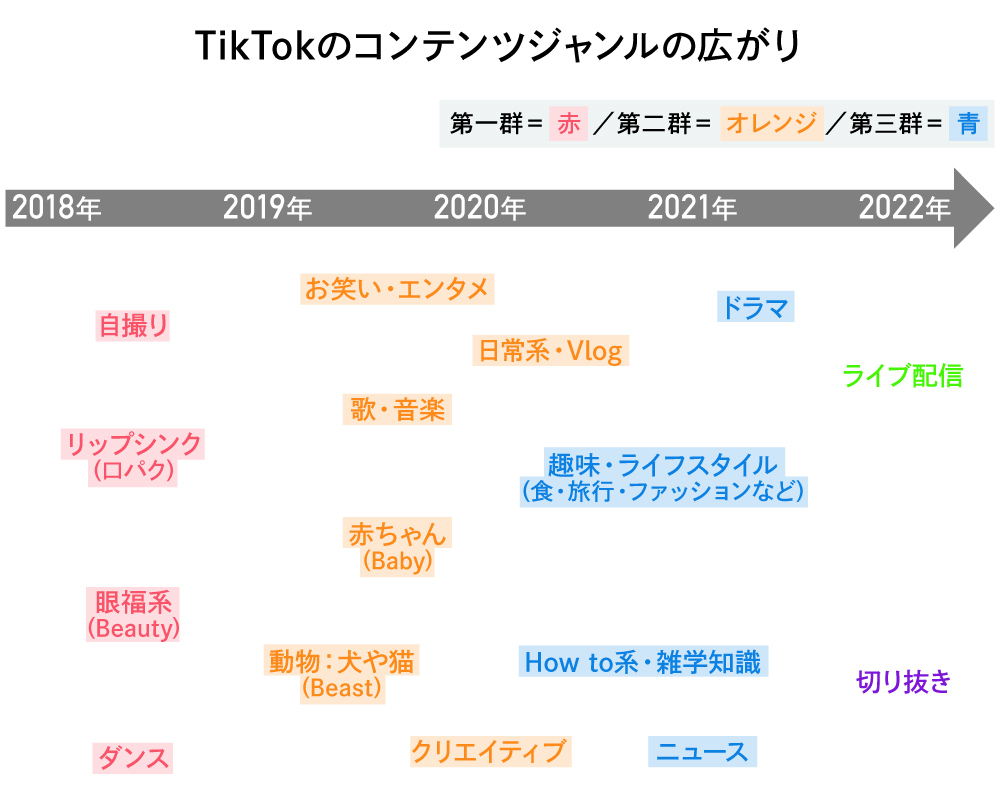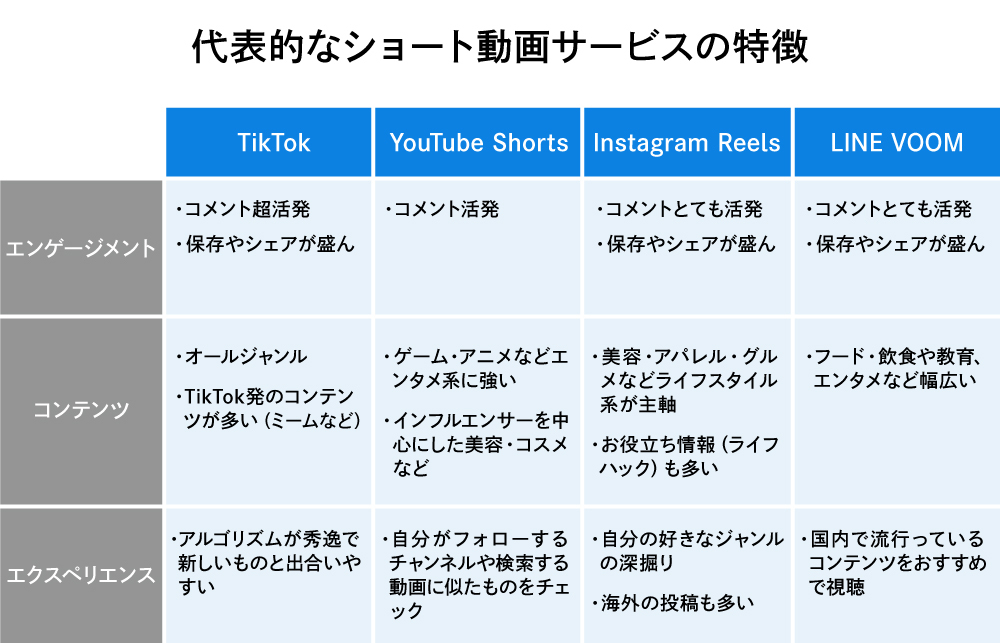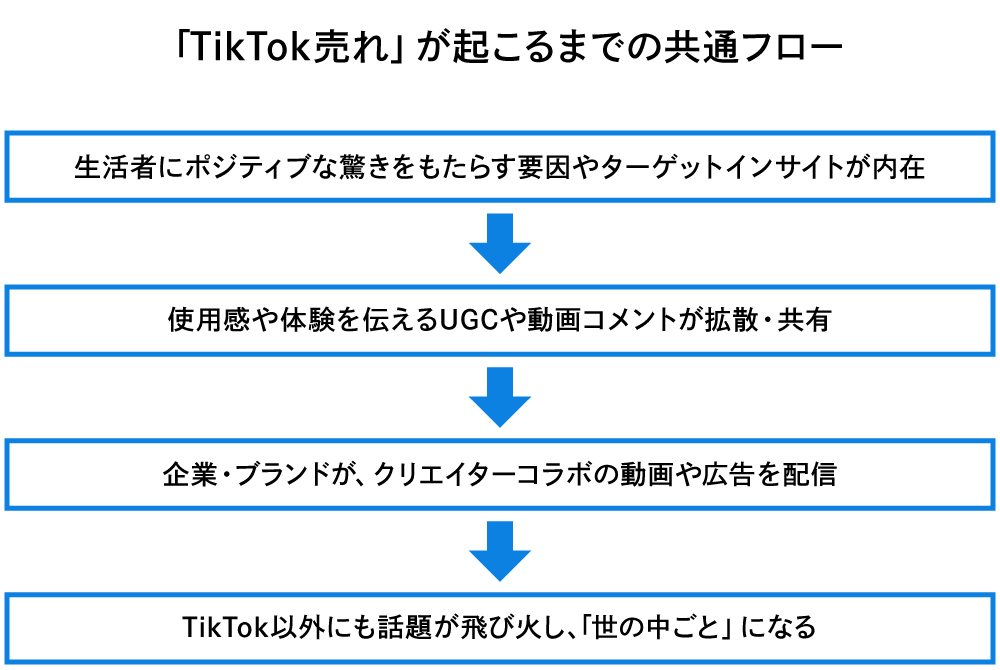In the first installment of this series, we discussed how TikTok and short-form video will evolve going forward, based on the current landscape.
This third installment focuses on the "TikTok sales effect" (where products or services gain traction and sell well after becoming a topic of discussion on TikTok), a phenomenon particularly noteworthy in the realm of social media marketing. We will examine what this phenomenon entails and why it deserves attention now, exploring it from multiple angles.
The first half touches on trends surrounding TikTok content and comparisons with other short-form video services. The second half outlines "TikTok sales." Building on this, we also introduce the relationship between "HYPE"—a contemporary form of trend the author is currently observing—and social media.
Content Evolution: From Entertainment to Information
As mentioned in Part 1 of this series, TikTok has significantly increased its user base in Japan over approximately six years since its launch (reaching about 28 million MAU as of February 2024). Consequently, the breadth of content on TikTok has expanded. The chart below summarizes this evolution.
※MAU (Monthly Active Users): Monthly active users. Data from AppAnnie
When TikTok began gaining traction in Japan in 2018, its core users were teenagers, primarily posting selfies, lip-syncs, and dance videos. If this represents the first wave, the second wave centers on elaborate entertainment videos—creative content featuring songs and visual effects, or comedy videos with punchlines.
Then, the third wave starting in 2020 saw an increase in content beyond entertainment like short dramas. This included information on trending restaurants, clothing, and cosmetics; daily news; and even useful lifestyle tips and educational knowledge. Search behaviors that previously involved Googling or tagging on Instagram are gradually shifting to TikTok.
To summarize this evolution succinctly: TikTok content is shifting "from entertaining content that's fun to watch to useful information that's valuable to watch." While the former relies heavily on personal skills and talent, the latter prioritizes the ability to curate useful information over creation itself. Essentially, anyone with an editor's discerning eye can create this type of content, making it accessible to a broader audience.
As the user base broadens in this way, shifting from entertainment to information is natural. This shift isn't unique to TikTok; various social media platforms have undergone it.
Recently, a pattern has also grown where creators combine multiple images without using video, then use trending audio to boost view counts. While this isn't strictly a "short video," it requires less effort to create and still delivers "easy-to-understand information," offering benefits for both creators and viewers.
Conversely, as people increasingly seek useful information, the importance of short videos as a "marketing platform" also grows. Sharing product knowledge or using them for advertising becomes natural. Creators focused on informational short videos are well-suited for promotional projects, and users tend to watch them with less resistance, making them highly effective.
Furthermore, the genres gaining prominence on TikTok since 2022 are "live streaming" and "clips." TikTok is now expanding beyond short videos into mid-length videos and live streaming. This can be seen as supporting creators by offering diverse features, or as encroaching on the territory of competing services like YouTube and Instagram.
"Clips" is a technique that captures attention by delivering only the highlights of longer, entertaining videos. Recently, accounts specializing in "clips" have increased. While widely accepted by modern viewers prioritizing time efficiency , caution is advised as some clips operate in a copyright gray area.
Representative Short Video Service Comparison
The short video space pioneered by TikTok now sees fierce competition from rivals like "YouTube Shorts," "Instagram Reels," and "LINE VOOM," intensifying the battle for viewers' limited free time. The table below summarizes each platform's key features.
Regarding user numbers, excluding TikTok, all three are essentially features within their parent services, making a strict comparison of MAU difficult. However, various statistics suggest that approximately 30-40% of the overall service's MAU are using the short video feature.
Regarding platform characteristics, as mentioned earlier, TikTok comprehensively covers videos across various genres. It also readily generates memes (a culture where funny images or videos spread virally), with unique TikTok video trends emerging daily. While videos created on TikTok may spread to other services, the reverse is less common.
YouTube Shorts, with its slightly higher male user base, features more anime and entertainment content. It also tends to show short videos from channels or genres you follow. Instagram Reels has a lot of lifestyle content like beauty and apparel, while LINE VOOM has a wide range of content including food, dining, education, and entertainment.
For short videos, the ease of commenting is also crucial. Videos with high viewer engagement are algorithmically favored and more likely to appear in " ." When discussions about a product or service occur there, users become more interested. TikTok has more active commenting than other services, which is a key factor in the "TikTok sales effect."
The Mechanism of "TikTok Sales"
In the entertainment business, short videos now dominate marketing activities.
K-POP, which is especially popular among young people in Japan, stood out in its use of short videos. In the 2010s, it was common for artists such as Girls' Generation and KARA to showcase their difficult songs and dances on YouTube. However, third-generation K-POP artists such as TWICE and SEVENTEEN have completely shifted to a strategy based on having fans cut clips and imitate them on social media to spread the word. They also mix hard and soft dance moves, incorporating catchy points into their choreography that many people can imitate, so that videos imitating those points spread like simulacra and are disseminated as cut-out videos.
Incidentally, I define a simulacrum as a visual image (a photo, video, or other symbol) on social media that everyone imitates, even though no one knows who started it.
The phenomenon of companies and brands creating hit products originating on TikTok, known as "TikTok sales," has also become established. "TikTok sales" became widely known after ranking first in Nikkei Trendy's "Top 30 Hit Products of 2021." Purchases are now being made on TikTok, mainly for apps, games, beverages, food, makeup, and skincare products, but also for more solid categories such as real estate and financial products.
Analyzing various cases that sparked "TikTok sales" reveals common patterns in how these products became hits.
1: The product inherently possesses factors that bring positive surprise to consumers or aligns with target insights
Fundamentally, it's crucial whether the product, service, or brand possesses an inherent appeal that draws people in. When people recognize this appeal, they become interested and want to tell someone or share it.
2: UGC and video comments conveying user experiences spread and are shared
Creators introduce and review attractive products and services in short videos, sparking buzz. This can be described as the aforementioned simulacrum diffusion. This can happen spontaneously, or it can proceed under careful communication design.
The spread of UGC (user-generated content) here also means how many comments the video attracts. As mentioned earlier, TikTok has a platform characteristic that makes it easy to comment on videos. It has recently become established that the more comments about products and services are included in such UGC videos, the more likely it is that attitudes will change, such as "wanting to know more details" or "wanting to buy."
3: Companies/brands distribute creator collaboration videos or advertisements
To maintain the volume of discussion from state 2, it's crucial for companies and brands to release videos created in collaboration with creators or to run additional ad campaigns.
4: The buzz spreads beyond TikTok, becoming a "worldwide phenomenon"
Through stages 1 to 3, the buzz spreads and becomes a "social phenomenon." In fact, many people learn about products or services trending on TikTok through web media, TV, or newspaper coverage.
Numerous studies conclude that the "ring media" effect—where UGC sparks buzz on social media, then spreads to other media and reaches the mass audience—is particularly pronounced today.
Of course, consumers' purchasing processes have become more complex. They don't buy immediately after learning about a product or service; they search for details and reviews, compare prices and specifications, and then make a decision. However, considering that how they first encountered the information influences the subsequent process ( ), increasing positive UGC and comments remains crucial.
The Era of HYPE Consumption
Finally, I'd like to introduce the keyword HYPE, which I find noteworthy. Dictionaries translate it as "hype" or "exaggerated advertising," terms often used negatively in the past.
However, in the realm of luxury fashion recently, this term has begun to be used from a different angle. Particularly in overseas media, usages like "trendy," "in vogue and gaining momentum," and "cool things everyone is obsessed with" have become established.
Looking at actual article headlines, you'll find several pieces arguing that luxury brands create HYPE and use it to boost sales. For example, phrases like "converts hype to sales" (Vogue Business, March 9, 2023) appear. Translating this as "exaggerated advertising" wouldn't make sense.
Of course, it's not that HYPE has shifted entirely to a positive connotation; it's more that a positive nuance has been added. It still carries the negative implication of being a fleeting trend, but conversely, this reflects an era where it's impossible to predict where trends will emerge. If planned, medium-to-long-term trends are impossible, then any trend is, to a greater or lesser extent, nothing but HYPE. And in creating this ever-shifting sense of "this is cool right now" (= HYPE), TikTok is now playing an extremely important role.
One of the products generating the most hype in 2023 was UNIQLO's "Round Shoulder Bag." This is the latest example of a "TikTok hit," ignited by videos from UK users praising its practicality. It also made major news by topping the "Hottest Products" category in the first quarter of 2023, as announced quarterly by fashion e-commerce platform Lyst. It gained such momentum that it pushed aside numerous hit products from other brands, earning a position among fashionistas that led to it being dubbed the "Millennial Birkin."
What's noteworthy about HYPE is that the biggest factor in creating trends has now shifted to the consumer's role in shaping reputation. Essentially, "(brand/publisher) reach < (consumer) reach" has become the norm.
While PR strategies and image campaigns launched by brands and publishers remain important, the significance of "Hype Creative" – content that generates positive UGC on social media – has grown more critical than ever.
In Part 2 of this series, we argued that our fundamental desire for connection and the motivation for "showing off" (ostentatious consumption) are what drive social media. In that sense, it's better to consider HYPE as something that inevitably accompanies our society.
While we cannot elaborate here, the reason numerous top global luxury brands mimic streetwear marketing strategies—like collaborations and drops (limited-quantity releases that appeal to scarcity and urgency)—is precisely because these are the optimal tactics for bottom-up buzz and reputation building, generating HYPE.
How is the sense of what people consider cool or trendy created?
The marketing and creative industries are deeply involved in this theme, yet it is inextricably linked to the evolution of the information environment and changes in how we communicate. Like trends themselves, it is constantly shifting form.









